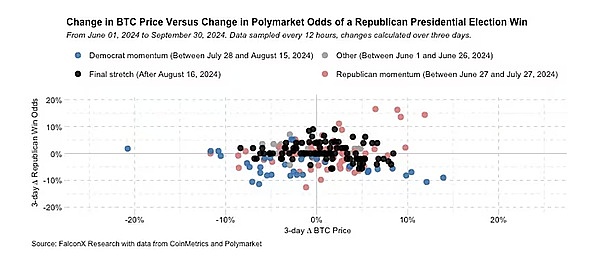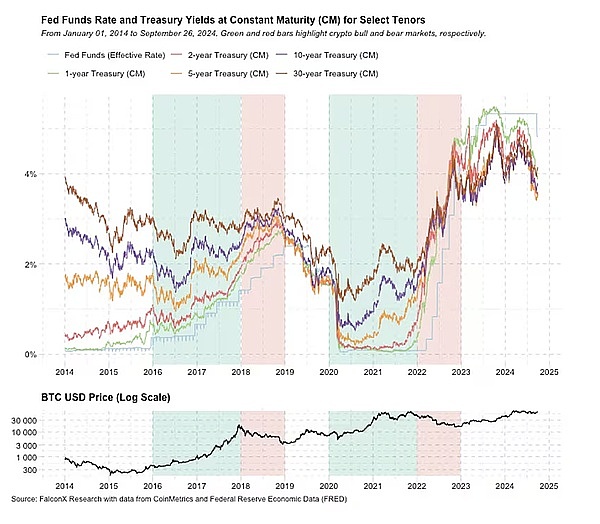Author: GWDX01
The US election coupled with easier monetary conditions could spark the next crypto bull run.
Major events often trigger cyclical shifts in crypto asset markets. The 2016-2017 cycle was largely industry-driven, expanding crypto’s influence beyond early adopters. In contrast, the 2020-2021 surge was driven by unprecedented COVID-era rate cuts.
Now, two powerful catalysts are converging: the looming 2024 US election and an emerging global liquidity cycle for risk assets. This powerful combination could break Bitcoin’s $58,000 to $70,000 trading range, where it has largely remained since late March, potentially triggering the next major market move.
The 2024 US election is likely to take on increasing importance as Election Day approaches.
This election cycle marked several firsts for cryptocurrencies, primarily how the industry became a relevant topic in political discourse and campaign financing. Another interesting trend is that the breakout crypto app Polymarket now offers real-time estimates of the consensus on election results, with over $1 billion involved.
The chart below shows the relationship between two factors over a 3-day period: the change in the odds of a Republican victory on Polymarket and the change in the price of Bitcoin, a proxy for overall crypto market performance. The different election phases are color-coded: gray for the initial phase (before June 26), red for the period of strong Republican momentum (late June to late July), blue for Democratic wins (late July to mid-August), and black for the final phase (since mid-August).

If the market were pegging cryptocurrency prices directly to Republican odds of winning, the points in the above chart would form an upward-sloping 45-degree line. Conversely, a direct link to Democratic odds of winning would show a similar but downward-sloping line. Instead, what we see is a scattered cloud of points, indicating that there is no clear, consistent trend between election results and cryptocurrency prices so far.
This dynamic is evident at various stages of the scatter plot, highlighted in different colors. Although the relationship is stronger during stages of strong Republican momentum, it still only explains less than 20% of Bitcoin's price movement.
This does not mean that elections are unimportant to cryptocurrency price action. It is possible, if not likely, that this relationship will strengthen as we approach Election Day (now less than a month away). But the inconsistent relationship suggests that other key factors have also been dominating price action in the cryptocurrency market.
The Interest Rate Outlook Suggests a New Regime for Crypto Prices
Recent changes in global liquidity have driven global markets, including the cryptocurrency market. The Fed’s strong start to this rate-cutting cycle, coupled with unexpected market-boosting measures from China, may have fueled the recent surge in cryptocurrency prices.
Unlike stocks, cryptocurrencies lack a lot of historical data to measure returns under different interest rate regimes.
Nevertheless, it is still instructive to study cryptocurrency prices based on the interest rate environment. The chart below shows the effective federal funds rate and the yield on U.S. Treasury constant maturities from 1 year to 30 years. To make it easier to understand, the chart below shows the USD price of Bitcoin (displayed on a logarithmic scale) with market cycles marked by color: green represents the 2016-2017 and 2020-2021 bull markets, and red represents the 2018 and 2022 bear markets.

The chart suggests that a soft landing with lower interest rates (the current consensus among investors) would create an unprecedented macro backdrop for cryptocurrencies. This scenario is different from the industry-driven 2016-2017 cycle and the COVID-era, rate-cut-driven 2020-2021 surge.
As a result, macroeconomic factors are expected to significantly impact cryptocurrency prices in the near term, as evidenced by the increased correlation between cryptocurrencies and broader risk assets.
Looking Ahead
Currently low cryptocurrency liquidity suggests that the market is in wait-and-see mode. While factors such as geopolitical tensions and supply-demand imbalances will continue to influence the market, the two main drivers most likely to determine the direction of the market in 2025 remain the upcoming elections and global liquidity conditions. The next one to three months will be critical in revealing how these trends will unfold.
 Clement
Clement
 Clement
Clement Catherine
Catherine Kikyo
Kikyo Clement
Clement Catherine
Catherine Clement
Clement Joy
Joy Clement
Clement Davin
Davin Kikyo
Kikyo